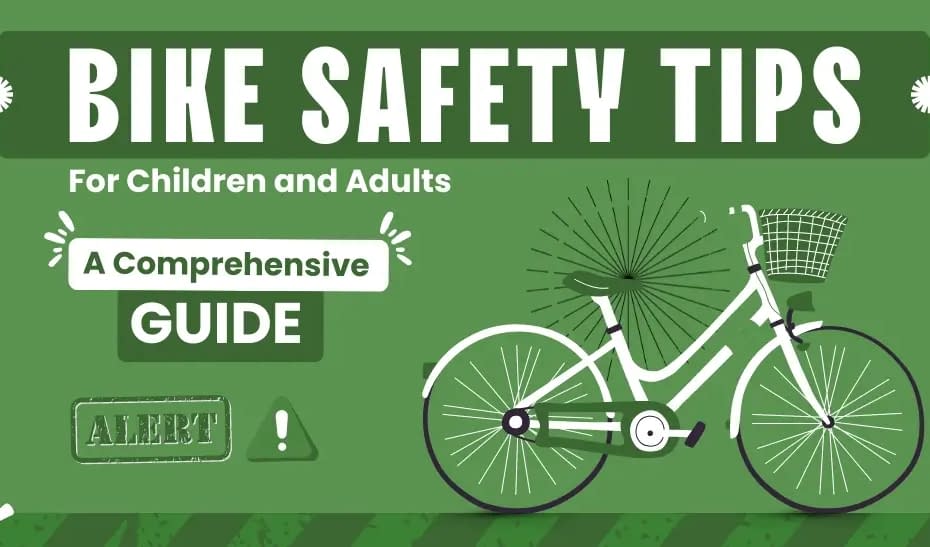Safety is paramount in cycling, regardless of age, gender, location, or experience level. Whether it’s a child learning to ride or an adult enjoying a leisurely spin, this article serves as a comprehensive guide to bike safety, covering everything from essential equipment to road rules and regulations. By following these tips, both children and adults can ensure safe and enjoyable cycling experiences.
Essential Equipment for Bike Safety
- Helmets: The Key to Health Protection: Helmets are non-negotiable for cyclists of all ages. They significantly reduce the risk of head injuries in accidents. Ensure the helmet fits properly, covering the forehead and fastened securely with straps forming a “V” shape.
- Bike Fit and Maintenance: Riding a bike that is the right size and well-maintained is crucial for safety. For children, the seat should be adjusted so both feet can comfortably touch the ground while seated. Regular maintenance of brakes, tires, and chains is essential for everyone’s safety.
- Visibility Gear: Being visible to others is paramount, especially at night. Wear bright-colored clothing and reflective gear to enhance visibility in low-light conditions.
Road Rules and Best Practices
- Follow Traffic Laws: Cyclists must adhere to all traffic laws, including obeying traffic signals, stop signs, yielding to pedestrians, and using hand signals for turning or stopping.
- Ride in the Same Direction as Traffic: Always ride on the right-hand side of the road in the same direction as traffic. This minimizes blind spots for drivers and reduces the risk of accidents.
- Utilize Bike Lanes: When available, use designated bike lanes for added safety and separation from motor vehicle traffic. However, remain vigilant for opening car doors and vehicles entering or exiting driveways.
- Be Predictable and Visible: Signal your intentions clearly to other road users. Ride in a straight line, avoid weaving between parked cars, and use hand signals for turns or stops.
- Stay Alert and Avoid Distractions: Maintain awareness of your surroundings at all times. Avoid using headphones or mobile phones while cycling, as they can distract you from potential hazards.
Special Considerations for Kids
- Supervision and Education: Young children require close supervision while cycling. Start with practicing in safe, traffic-free areas like sidewalks, paths, or parks. Gradually introduce them to road cycling under adult guidance as they gain skills and confidence.
- Choose Safe Riding Areas: Initially, children should practice in controlled environments away from traffic. As they progress, gradually introduce them to quieter streets with less traffic.
- Lead by Example: Adults play a crucial role in modeling safe cycling behavior for children. By following the rules, wearing helmets, and demonstrating responsible riding habits, adults set a positive example for young cyclists to emulate.
Additional Bike Safety Tips for Everyone
- Informative and Fun Activities: Engage children in interactive and enjoyable activities to teach them bike handling skills, such as balance, braking, and turning. These skills are invaluable for safe cycling on roads.
- Emergency Preparedness: Always carry a basic toolkit, spare tube, and pump for on-the-go repairs. Being able to fix a flat tire or adjust settings can prevent delays and ensure a safe return.
- Route Planning: Plan your routes in advance, especially for longer rides. Choose roads with less traffic and adequate bicycle infrastructure whenever possible. This minimizes risks and enhances the overall cycling experience.
- Ride with a Buddy: Cycling with a companion not only makes the ride more enjoyable but also increases visibility to drivers and provides assistance in case of an emergency.
- Adjust for Weather Conditions: Adapt your riding style to different weather conditions. Wet surfaces require longer braking distances and strong winds can affect balance, so exercise caution and adjust your speed accordingly.
Conclusion
Cycling is a fantastic activity for people of all ages, offering numerous health benefits and enjoyment. By adhering to the bike safety tips outlined in this guide, cyclists can significantly reduce the risk of accidents and injuries, making every ride safer and more enjoyable. Remember, safety is a shared responsibility. Whether you’re cycling, driving, or walking, prioritize the safety of yourself and others on the road. By following these guidelines and setting a positive example, we can all contribute to a safer cycling environment for everyone.
FAQ
At what age should children start wearing helmets while cycling?
It is recommended that children wear helmets as soon as they start riding a bike, even with training wheels.
Are there different types of bike helmets for different cycling activities?
Yes, there are helmets designed for specific cycling disciplines, such as road cycling and mountain biking. Choose a helmet that is appropriate for your intended use.
